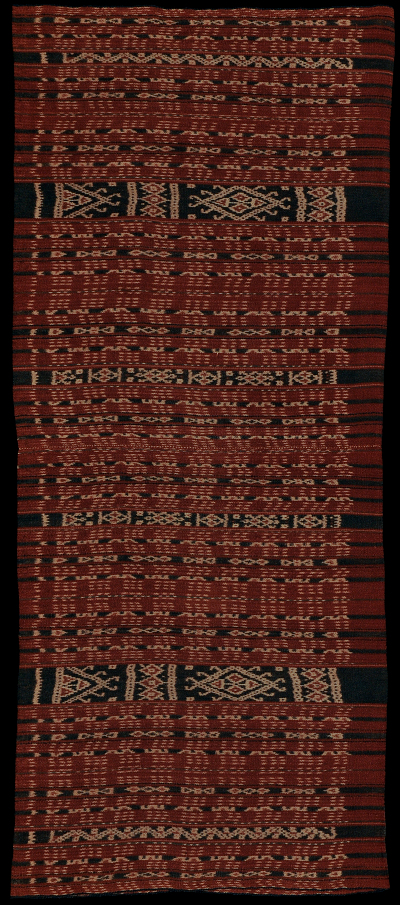| |
 
 | | | |
128 Flores Group, Peninsula
Kewatek (sarong)  
| | Locale: | Demo Pagang, near Bama (between Bama and Nobo in the Lewo Tobi area), Lamaholot people. | | Period: | 1930-1950 | | Yarn: | Cotton, hand-spun, medium | | Technique: | Warp ikat | | Panels: | 2 | | Size: | 61 x 146.5 cm (2' 0" x 4' 9") LW: 2.40 | | Weight: | 775 g (27.3 oz), 434 g/m2 (1.42 oz/ft2) | | Design: | Two bands, kenirek belen, with rhombic and half-rhombic motifs in white on indigo, hooks along the sides, which bring up associations with the kaif motifs of Timor. Two narrower bands with star-like motifs, numerous stripes with small decorative elements in the same colours, all on morinda background. The (invisible) weft is morinda instead of indigo, consistent with the unique practice typical for the area. The fact that the indigo is not overdyed with morinda identifies this piece as Bama, rather than Ili Mandiri. | | Comment: | Old, full asli bridewealth sarong, called kewatek méan, with masterful weaving in excellent condition. A rare example of the high quality weaving that gave this region its renown. | | Background: | Chapters on Flores Group and Peninsula. | | Exhibited: | Museu do Oriente, Lisbon, 2014/15.
Hong Kong University Museum and Art Gallery, 2017. | | Published: |
Woven Languages, 2014.
Ikat Textiles of the Indonesian Archipelago, 2018.
| | Compare: | 007 097 211 | | Sources: | Very similar to kewatek shown in Khan Majlis, Woven Messages, Fig. 180. The piece, from the Rautenstrauch- Joest Museum is identified as Bama, which can be hard to distinguish from Ili Mandiri. Very similar also to Bama kewatek in Barnes and Hunt Kahlenberg, Five Centuries of Indonesian Textiles, p. 307, Fig. 7. A similar but more basic piece shown in Fig. 179 is given the provenance Ili Mandiri or Bama. Our specimen has superior detailing, tighter execution. Also similar to kewatek in Maxwell's contribution to Gittinger c.s., Indonesian Textiles, Fig. 7 lower right, identified as Bama. As of 2018 no other published examples known. Name of village of origin provided by Antony Lebuan. | | |

©Peter ten Hoopen, 2025
All rights reserved.
|
|


